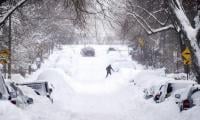Find a different, more diverse Karachi in a new hardback
What started out as a discussion in a private Facebook group — ‘Karachi Uroos Ul Bilaad [Bride of Cities] Group’ — has resulted in a book titled ‘Iss dasht mein ik shehr tha’ (There was a city in this desert).
Apparently taking its name from a line of the song ‘Aawaargi’ (Wandering), which was sung by Pakistan’s renowned ghazal singer Ustad Ghulam Ali, the book is subtitled ‘Karachi kay sunehray dinon ki daastaan’ (The story of the golden days of Karachi).
Iqbal A Rehman Mandvia’s 800-page book covers over 300 topics that include artists, musicians, other personalities, religious and ethnic communities, places of worship, heritage buildings, roads, streets, markets, cinemas, educational institutes, libraries, hospitals, hotels, restaurants, food streets and residential colonies.
Some of the subjects have been presented in the book with new or additional information, while under several other topics, the author has tried to correct the disputed facts about the city.
Another important aspect of the book is its focus on the areas, chowks, roads and streets named after women, such as Gulbai Chowk, Chand Bibi Road, Fatima Jinnah Road, Victoria Road, Jamila Street, Zaibunnisa Street and Zehra Street.
The book also covers the communities that had migrated to Karachi from other countries. After 1970, however, when movements for Islamisation emerged in Pakistan, an overwhelming majority of those communities left the city, leaving behind very few families. They included Goans, Parsis, Sikhs and Anglo-Indians.
Important chapters
The book includes some rare pieces of information divided into subtopics and chapters. The writer has verified stories from reference books, archives, libraries, and other writers and historians.
Some of the chapters contain interesting and fresh information on old topics, connecting today’s Karachi with its history, culture and pluralism. Both casual readers and serious researchers will find a different Karachi in the book — one that was once more diverse than it is at present.
Zaibunnisa Street
The street links Karachi’s most historical road, Sharea Faisal, with the busiest market of Saddar Town. Zaibunnisa Street is well-known among the old inhabitants of the city as Elphinstone Street, or simply Elphi Street.
Some people believe that Elphinstone was a British woman. But they are wrong. This street was named after Mountstuart Elphinstone, a Scottish statesman and historian associated with the British Indian government.
He served as governor of Bombay from 1819 to 1827. He was the first person to set up several educational institutions that were accessible to local Indian students. In 1951, the Karachi Metropolitan Corporation (KMC) named this street after Maulana Muhammad Ali Jauhar. However, on May 26, 1970, the Jang newspaper stated in an article that Elphinstone Street was named after the Mughal princess Zaibunnisa, who was the daughter of Emperor Aurangzeb.
In the 1970s, a group of people launched a campaign to rename roads, streets, neighbourhoods, buildings and other public places. The author says that in September 2000, a misinformed article published by the Dawn newspaper created another misconception that Zaibunnisa Street was named after a journalist named Zaibunnisa.
Later, an entry about Zaibunnisa Street appeared on Wikipedia that quotes the Dawn article. Now people believe Zaibunnisa Street to be named after the journalist. But historians claim that it was named after the princess.
Gulbai Chowk
Today’s Gulbai Chowk was an area outside the city. It was a seashore. On this site are 10 graves, about which a number of legends are famous. Some say they belong to the brothers who went out for hunting.
According to the legend, when they were returning home, a shark attacked them and swallowed them. But some say it was not a shark but a crocodile. Perhaps no one knows the real story behind those graves.
In 1854, Seth Rustam Jee Mehta acquired a licence from the British government to start a salt-producing company. Mehta named the factory ‘Gulbai Salt Works’ after his wife. Though the factory is no longer there, the area is still known as Gulbai Chowk.
Mira Naka
The neighbourhood located in Lyari Town near the Shershah scrap market was the dead-end of Karachi, or rather of Sindh’s border with Balochistan. At this point, border guards collected taxes from trading convoys of Lasbela and Kalat, and Afghanistan and Iran. Paying the taxes on the border of Mira Naka, the traders crossed the border into Karachi. Later, during the British dominancy in Sindh, this area was merged with the city.
Gandhi Jee Street
The area opposite the Dow Medical University is called Thathai Compound, where Taj Masjid is located. The street that leads towards Lighthouse was named after Mohandas Karamchand Gandhi when he had visited Karachi.
At that time, some influential Hindu members in the KMC were residing in the area. They were from Thatta. This is why the area came to be known as Thathai Compound.
After Partition, the street was renamed after Yaqoob Gandhi, who later established the ARY Group of Companies. “Gandhi Street of Karachi is still Gandhi Street. But it has been renamed after a Muslim Gandhi,” writes the author.
Goan community
It is believed that the Goan community came to Karachi in 1820. Initially, the community opted for the Saddar area to reside. In 1860, the community established the Goan Union Hall, which is still standing at a corner of Lucky Star Chowk.
As the Goan population kept increasing, the community was allotted pieces of land by the government in 1926 and they settled there. The settlements that the community established were in the surrounding areas of Saddar, Soldier Bazaar, Mission Road, Garden and Napier Road.
In 1970, Goan community leader Francis E Lobo participated in an election from Karachi and received adequate votes, but he lost the poll. When Islamisation started in the 1980s, most of the community gradually left the country.
However, The Karachi Walla blog claims that 15,000 Goans still live in the city. Renowned journalist Cyril Almeida, who recently left the country, belongs to the Goan community.
Polish migrants
During World War II, when Germany attacked Poland, over 30,000 Polish refugees migrated to Karachi between 1942 to 1945 for temporary residence. They were settled in migrant camps at the Country Club and in the Malir area.
The graves of some 58 refugees who passed away during their stay in the city are still here. In 2005, the Polish consulate launched a memorial to honour those who lost their lives during exile.
Diplomats wrote many details on the plaques that will be very interesting and informative for students of history. After Partition, however, while majority of the refugees returned home, a few families decided to become permanent residents of the city. The Polish joined the newly established Karachi University as faculty members. Some of them also served in the Pakistan Air Force.
Feedback on book
“This book is an interesting picture of today’s Karachi,” says prominent historian and researcher Gul Hassan Kalmati. “It includes every colour that reflects the author’s affection for the city. The author praises the city and narrates the stories of the gone days with sorrow.”
Well-known author Aqeel Abbas Jafri says Mandvia has preserved the history of Karachi’s streets in the book along with the personalities after whom the roads and streets of the city were named.
Jafri says the book discusses where the original Guru Mandir was, if Zaibunnisa Street was named after late journalist Zaibunnisa or princess Zaibunnisa, which of the thoroughfares have been named after Gandhi, Motilal Nehru or Jawaharlal Nehru — this book reveals much valuable information.
Citing more examples, he says the book mentions which road was named after Rattanbai Jinnah’s grandfather, how a thoroughfare became Japani Road, what Jamshed Road’s real name was, where Gandhi Street is located, who built Bombay Bazaar, and why Delhi Colony residents named mosques, shops and schools after India’s capital.
Weaknesses in book
Though Mandvia’s book contains verified stories about old Karachi, it does not mention every source or reference for those pieces of information, and especially lacks a much-needed bibliography.
In some parts of the book, the author seems to be unfairly venting his anger on the people who apparently refused to cooperate with him or give him access to the required information.
Moreover, Mandvia has included poetry in every chapter of the book. Some scholars believe that poetry deals with emotions, so a book like this that deals with history needs concrete facts.
The author, however, appears to pine for the glorious past of Karachi. He tells every story without any bias. The book basically compares and correlates today’s Karachi with its wonderful past. It tells the readers how the city’s residents had promoted a pluralistic culture with the flavour of all local colours.
Family of writers
Iqbal A Rehman Mandvia is a businessman who also has a travelogue titled ‘Jannat-e-Arzi: Istanbul’ to his credit. His father Abdul Rehman Aseer was the author of a Gujrati book titled ‘Memon qaum ni utpati’ (Origin of the Memon community). Moreover, his uncle Yousaf Mandvia was a renowned Gujrati journalist and writer. He was the editor of the Mujahid newspaper that was published from the Indian city of Junagadh.
-
 Canada And China Trade Deal: All You Need To Know About The New Agreement
Canada And China Trade Deal: All You Need To Know About The New Agreement -
 Tyler Hilton, Megan Park Call It Quits After 10 Years Of Marriage
Tyler Hilton, Megan Park Call It Quits After 10 Years Of Marriage -
 Prince Harry’s Fears Turn Concerning As Archie, Lilibet Slip Too Far Out Of Reach: ‘Their Too American’
Prince Harry’s Fears Turn Concerning As Archie, Lilibet Slip Too Far Out Of Reach: ‘Their Too American’ -
 Former Nickelodeon Star Kianna Underwood Dies At 33 In Tragic Hit-and-run
Former Nickelodeon Star Kianna Underwood Dies At 33 In Tragic Hit-and-run -
 Prince Harry Risks Straining Marriage To Make Archie, Lilibet Make Emotional Demand Of Meghan
Prince Harry Risks Straining Marriage To Make Archie, Lilibet Make Emotional Demand Of Meghan -
 Sarah Ferguson’s Pal Reveals What She Really Thinks Of Beatrice, Eugenie Choosing A Royal Christmas
Sarah Ferguson’s Pal Reveals What She Really Thinks Of Beatrice, Eugenie Choosing A Royal Christmas -
 North West Raps About Piercings, Tattoos And Skipping School In New Song
North West Raps About Piercings, Tattoos And Skipping School In New Song -
 Teddi Mellencamp Shares Hopeful Health Update Amid Cancer Battle: 'Cloud Is Lifting'
Teddi Mellencamp Shares Hopeful Health Update Amid Cancer Battle: 'Cloud Is Lifting' -
 Prince William Makes Clear The Conditions He Has For Meeting Prince Harry
Prince William Makes Clear The Conditions He Has For Meeting Prince Harry -
 Sara Foster Slams Age Gap Relationship After 'blah' George Clooney Date
Sara Foster Slams Age Gap Relationship After 'blah' George Clooney Date -
 Jennifer Garner Recalls Enduring Ben Affleck’s Intense Beyoncé ‘Halo’ Phase
Jennifer Garner Recalls Enduring Ben Affleck’s Intense Beyoncé ‘Halo’ Phase -
 Prince Harry’s Mental Health Ends Up At Stake As Meghan Moves Him To 'second Fiddle'
Prince Harry’s Mental Health Ends Up At Stake As Meghan Moves Him To 'second Fiddle' -
 Bradley Cooper On Who His Mother Thinks Is The World’s Best Actor
Bradley Cooper On Who His Mother Thinks Is The World’s Best Actor -
 Meghan Markle Offers Glimpse Into Intimate Dance Moment With Harry Amid Split Rumors
Meghan Markle Offers Glimpse Into Intimate Dance Moment With Harry Amid Split Rumors -
 Jon Bon Jovi Joins The Viral 2016 Throwback Trend With Nostalgic Photos
Jon Bon Jovi Joins The Viral 2016 Throwback Trend With Nostalgic Photos -
 Kate Middleton Hailed For Her Lack Of ‘obligation’ As Well As Altruistic, Selfless Qualities
Kate Middleton Hailed For Her Lack Of ‘obligation’ As Well As Altruistic, Selfless Qualities



